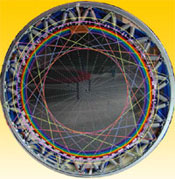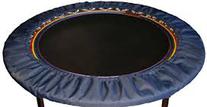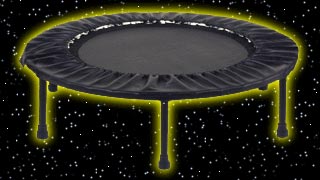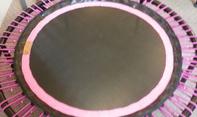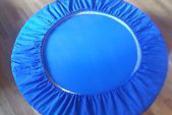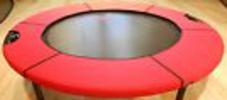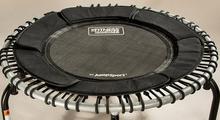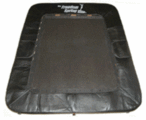Before I even sold any rebounders, I wanted to know what the differences were between them. Every company said they had the best one. How can there be 5 best ones!! How could every rebounder be the best when all of them felt so differently. Some rebounders had single tiered springs, others had triple tiered
springs. The barrel type springs felt totally different than the tapered springs. Others rebounders gave fewer bounces per minute. Others rebounders gave more bounces per minute. Some rebounders bottomed out while others were so firm that it hurt my knees.
I now feel that I can give an honest recommendation after selling rebounders since 2003 and listening to feedback from happy and unhappy customers. I know which rebounder brands have springs that get weak and lose their G force and others that feel the same as when I first bought them. I know which rebounders have problems two years down the road. I know which rebounders that have paint that chip and then get rusty. I know all the little things that competitors say that are not true about their rebounders and know which claims are true but not in
the long run as the rebounder ages. I know how to tell if a rebounder just passed the production line test by the sound of the springs when I tap on the springs each with a spoon. (I even bought a guitar tuner and sampled each spring.
My goal is to make sure people get a rebounder that will fit their weight, their style, feet positioning, and I will take into
consideration if there is any pronation or inversion of the ankle problems or too much or too less ballistic impact depending on how heavy someone is to get the most bounces per minute to squeeze the one way valves in the lymphatic vessels in the body. Having just the right bounce with enough bottom time and less "air" time will be the rebounder of my choice. Better said, I want to find the rebounder that first gives the optimal Health bounce. Not everyone likes a firm bounce. Some people can handle the Lymphaciser while other people need a really soft bounce from a Cellerciser. Some people will want a really soft bounce like from the Needak but don't mind sacrificing the G force and fewer bounces per minute. The Cellerciser gets many more bounces per minute and more G force than the Needak but fewer than the Lymphaciser when is desined for only the Health bounce. If I bounce even a little high out of the mat its not so comfortable. i give the Cellerciser an A for the health bounce but the Lymphaciser an A+. I guess the needak since its so much better than all the others will get an A-. Still an A but just a few points after the Cellerciser. The Rebound Air, it is actually designed for the Health bounce but all I can say is try it for yourself and as long as you get a 30 day return policy and you don't have to pay restocking fees or shipping back, then why not see for yourself. You will never hear me trash talk another brand.
Email me your questions here and they'll be posted here with responses like the ones below.
Which is the best rebounder if someone is over 300 lbs?
The Cellercsier and the hard bounce Needak Rebounder has the strongest springs that can handle the most weight that I have tested.
What makes for good rebounding suspension?
First thing that comes to mind is the quality of the spring steel. An alloy with higher carbon is ideal for longevity and wear resistance. Always get the lowdown, you can avoid a $100 spring set replacement fee if you stay vigilant about this. Barrel-style springs will wear the quickest and represent the bottom of the barrel as it were, tapered (oblong form) springs mitigate some stress, but tiering a tapered spring design will not only up the longevity factor, but fix some of the two formers' issues with jarring and even noise. Plus, tripple tiered style springs adapt to the weight of the person the best.
Bungees are fantastic fun and I can't disrecommend them, but they don't deliver precision in the bounce and I never recommend them for the Health bounce or any type of lymphatic rebounding that involves barely leaving the mat.
You mentioned that a unibody isn't necessarily the best frame construction. How can a frame be more rigid if it's in pieces?
Generally, folding frames can't match a unibody's frames rigidity, provided that the unibody in question is torsionally sound. Models that are articulated for travel and portability have engineering afterthoughts for hinge hardware. Exceptions can be found by holding the frame and both sides of the hinge with your hands when the structure is deployed. If there is noticable play in the hinge mechanism, that means there will be impact occurring at that point and over time, the structure will surely fail. You can have quality in a folding frame, but you will pay extra for the engineering quality, however, compared to replacing a frame, the premium over the low tech pays for itself.
Does the rebounder company use canvas mats?
Avoid canvas mats. The new state of the art rebounding material is Permatron, which is made expressly for this kind of application. Canvas rebounder mats stretch, even rot and mildew. A stretched rebounder mat will throw you off balance and cause injuries.
What kind of surface should I place my rebounder on?
Any even or flat surface like a floor, deck or patio (i use my garage floor) will do. It's important, also, to consider the leg and foot construction of the rebounder you're using. The rebounder feet are commonly rubber, which can scuff heavily and wear out quickly. The best I've found is polymer feet. Just make sure they have the feet with a metal washer inside to keep the leg tube from chewing into the foot.
How often do springs need replacing?
Ideally never, the highest quality carbon steel springs with optimal taper and tiering will not need replacing if they're made correctly. Alert: If a dealer tries to sell you an extra set of springs with a new rebounder, beware they probably won't be the last extra set you'll have to buy. Also, look for consruction that isolates the springs from the frame with a pin or some kind of subframe: otherwise they will eventually wear or scrape away at the frame, causing rust or other damage.
Newer questions answered about rebounders.
Q. Why do some rebounders require people to change the springs every 2 years and not others like the Cellerciser?
A. Because they stretch out from weak, low carbon, lower tensile steel. They can look the same and perform nearly the same in the beginning. But, after 3 months is when most people complain about their rebounder when they notice the stretching. The springs rarely break but just lose their tensile and yield strength which many people think is nice because the bounce becomes softer but the Health bounce becomes less and less.
Q. Which rebounder is the best for over 200 lbs.?
A. One that supports you and designed to support this weight or can adapt to this weight. The Cellerciser and Needak Hard bounce are my favorite. If right at 200 the Lymphaciser is good but can feel a little jarring if you bounce to high.
Q. Whats the main thing to look for in a quality rebounder?
A. 1st thing, the mat and the spring structure...2nd, the frame integrity and welding..3rd, the supporting parts, the rubber feet and spring covers. The Cellerciser, Needak, Bellicon, and Lymphaciser are my top 3 as far as high quality engineering. The Cellerciser is the most advanced in the spring rebounders and the Bellicon for the bungees.
Q. What happens if I sweat on the rebounder or leave it outside in the rain?
A. Some can rust and others don't. On high end rebounders, they don't rust but oxidizes. Example: Oxidation is when a car paint changes color but doesn't rust. A good quality electroplated painting protects against rust. The bungees you definitely need a cover for so they don't get loud. I have had my Cellerciser outside for 2 winters and 2 summers, nothing was effected. I did have the cover off and none of the springs rusted nor any of the frame. The other rebounders totally rusted and were a mess but didn't affect the performance, just the looks.
Q. Why does my rebounder squeek so much?
A. Oil it silly! Good quality steel will squeek more than low quality steel. There is more friction potential. The Cellerciser before it was coated with the dual silver alloy, made a terrible noise I heard. Now it has a dual coating but that coating still makes noise when the hooks rub the frame. Note: the springs don't make noise, its the rubbing of the hooks that rub the frame. Always oil both ends of your springs so that the springs will not fatigue. Fatigue causes the rebounder spring to heat and cool repetitively which causes the spring to become weak and break. Many people use sprayable graphite which for most people will make any spring rebounder noise free for at least 10 years if you do it right. That is what people tell me. I know a guy that used to use graphite back in the 70s who took apart guns in the Navy Seals so they would be water proof. This was the guy who told me about it. It takes about 4 hours for someone to apply it. Much more time consuming than putting a drop of oil but its worth it according to everyone who does it.
Q. How do I know which rebounder springs should be replaced without replacing them all?
A. See spoon test. Or buy a better spring set from the start. I always weigh them to see if they all weigh the same on the scale. I want to return the springs that aren't the same. It bugs me if I have half my springs just say 92 grams, some of them 90 grams and a few that are 93 and 94 grams.
Q. Will the rebounder quality diminish after a few years?
A. Some will and some won't. A better quality rebounder should last at least 20 years. Cheaper rebounders need to be replaced every few years. Usually the part that breaks is the mat or where the hooks go in if the frame is low quality.
Q. How do I clean my rebounder?
A. Hose it off if the rebounder is water resistant but if not, then wipe it with a damp towel. If you don't dry a non water resistant model, the corrosive elements can make it rust. Near the beach, hose off a rebounder once a week if left outside. Electroplated models doesn't really need to be dried off. People in florida near the beach leave their Cellerciser by their pools and I have never heard a complaint.
Q. Is a plastic rebounder frame or metal frame better?
A. Metal always. Common sense.
Q. Are heavier springs better than lighter rebounder springs?
A. This cannot be answered this way. It depends on the component material of the springs. The Lymphaciser springs are tiny almost like those 50 dollar rebounders but have high carbon while some springs like the Needak have to replaced every 2 years to keep up their tension.
Q. Why is my rebounder making all these black marks on my rug?
A. Cheap rubber tips can wear down much faster. That is all it is doing. Polymer feet will not mark up the rug.
Q. How do I prevent mold from developing under the rebounder's spring cover?
A. Mold resistant spring covers are usually the water resistant type. Canvas type covers mold quicker. Anytime a reboudner can hold dampness, it can mildew and mold. Not good.
Q. What do I do to prevent paint from chipping off my rebounder frame?
A. Get an electroplated painted frame and avoid a powder coated paint that flakes. Or you can get a solid stainless steel frame that has no paint at all.
Q. My rebounder springs have stretched and it's only been a year. Why is this happening?
A. Cheap, low carbon steel springs are almost always the cause or they weren't rated to the weight of the user.
Q. My rebounder is wobbling due to something that has caused the frame to warp. Why?
A. This is usually from an inferior quality rebounder frame that has had poor quality control. Always check your rebounder when you get it to make sure the legs are evenly supported on the ground. Some people have to duck tape one of the legs to keep the rebounder from wobbling.
Q. Can a mat rip when jumping on it?
A. A good quality rebounder mat made of Permatron will not rip like nylon or canvas or plastic mats. An inferior mat will tend to throw you off which will let you know the mat has stretched or weakened. An inferior mat will not support you properly which is why it will throw you off.
Any rebounder should be help drain the lymphatic vessels and clear the lymph nodes. By doing things to get rid of the acidity in the body and manually squeezing each of the one way valves to empty out the wastes from the cells, the process should go faster. Joint pain and circulatory issues are usually the sign of this not working. I always ask if people have weak ankles and knees or a bad back. This is not because of an injury usually, but from major acidity in the joints.
The BEST Rebounder:
1. Will not invert you ankles that causes it pain, even when jumping in the middle or putting one foot on the edge and one foot in the middle.
2. Will give at least 3 g forces that's usually enough force to flush the thickest, viscous stagnant lymphatic waste.
3. Will never jar to allow deep breathing without jarring the lungs. (The rib cage plays a big role in pumping lymph fluid. Shallow breathing while rebounding makes rebounding much less efficient.
4. Will give quicker G forces, NOT THE LONGER G FORCES. Softer or deeper bounce rebounders can feel great to jump on but if there is not enough g force to TOTALLY ""CLOSE"" A ONE WAY VALVE IN THE LYMPH VESSEL, THEN NOTHING FLUSHES. You can get a great workout but not a lymphatic workout. Take for example a stationary bike, you burn calories but not enough G forces on the whole body to give the body a lymphatic flush like a rebounder.
5. Gives more bounces per minute at a 3 G force level at the Health Bounce Rate. See health bounce page.
6. If scraping the sweat off your body wth a shimmy and put into a cup... their should be a larger amount of the oily residue than the water based sweat you normally get from being outside in the sun or walking on even pavement. (You can also put the cup outside in the sun and see what the filmy residue looks like after the water has evaporated.
7. If bouncing a bowling ball on the rebounder, the ball bouncing on the edge should be a linear proportion increase of the center of the rebounder. Inferior rebounders have a very firm outer edge and a significantly softer center spot which can throw you off.
Remember, you either are DOING THE HEALTH BOUNCE RIGHT OR YOU ARE NOT. THERE IS NO GUESSING IF YOU ARE DOING IT. I ALWAYS LAND ON MY HEELS AND THEN ROLL TO THE TOES AND PUSH OFF WITH MY TOES. MANY PEOPLE REBOUND FOR YEARS AND LAND JUST LIKE THEY WOULD IF THEY WERE JUMPING ROPE. I URGE PEOPLE NOT TO MAKE THE MISTAKE MANY PEOPLE MAKE.
Take the
Take the
AVOID RIPOFF: DO NOT BUY ANY REBOUNDER BEFORE READING THIS
Beware of bogus rebounder reviews and fake comparison websites.
See the list of tricks rebounder companies use to trick you here.
1-877-354-3778
Open 7am till 11pm Eastern
Lymphaciser
LymphaticRebounding.com
Cellerciser
Bellicon
Needak
Rebound Air
URBAN
Lympholine
JUMP SPORT
Hexagonal
Bungee
Freedom Spring
1-877-354-3778
Open 7am till 11pm Eastern
